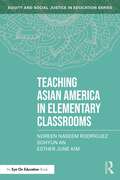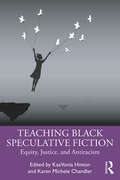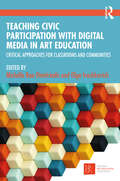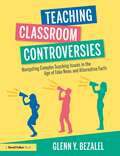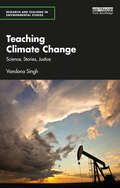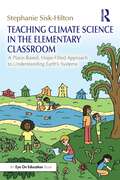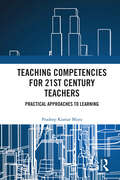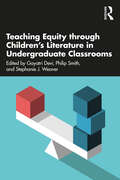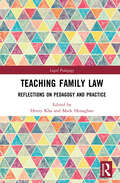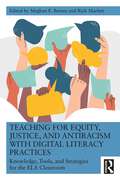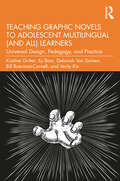- Table View
- List View
Teaching Architecture: The New Age of Digital Design (Routledge Focus on Design Pedagogy)
by Sadiyah GeyerIn the post-COVID era, understanding the profound impact of digital technologies on design pedagogy is crucial. This book delves into experimental design education, showcasing projects utilising technology to transform creative and analytical processes.Emphasising the potential for digital-era technologies to create novel educational opportunities, the book addresses recent global events and their role in minimising educational disruptions in the evolving hybrid educational landscape. Each chapter offers case studies exploring digital technology's influence across architectural education, spanning interior design, urban planning, parametric digital design, architectural conservation, and design analysis. Contributors envision the hybrid virtual design studio’s future and discuss the collaborative role of digital technologies in urban design projects. The book analyses contemporary parametric design processes and machine learning through innovative historical case studies, examining new technologies in architectural conservation.With case studies from diverse locations, including South Africa, Turkey, the UK, and the United States, the book provides a global perspective on the influences and potential futures of digital technologies in architecture. Essential for those interested in the future of spatial design education, this book illuminates the pivotal role of technology in shaping its trajectory.
Teaching Asian America in Elementary Classrooms (Equity and Social Justice in Education Series)
by Noreen Naseem Rodríguez Soyhun An Esther June KimAsian American voices and experiences are largely absent from elementary curricula. Asian Americans are an extraordinarily diverse group of people, yet are often viewed through stereotypical lenses: as Chinese or Japanese only, as recent immigrants who do not speak English, as exotic foreigners, or as a “model minority” who do well in school. This fundamental misperception of who Asian Americans are begins with young learners―often from what they learn, or do not learn, in school. This book sets out to amend the superficial treatment of Asian American histories in U.S. textbooks and curriculum by providing elementary teachers with a more nuanced, thematically driven account. In chapters focusing on the complexity of Asian American identity, major moments in Asian immigration, war and displacement, issues of citizenship, and Asian American activism, the authors include suggestions across content areas for guided class discussions, ideas for broader units, and recommendations for children’s literature as well as primary sources.
Teaching Asian America in Elementary Classrooms (Equity and Social Justice in Education Series)
by Noreen Naseem Rodríguez Soyhun An Esther June KimAsian American voices and experiences are largely absent from elementary curricula. Asian Americans are an extraordinarily diverse group of people, yet are often viewed through stereotypical lenses: as Chinese or Japanese only, as recent immigrants who do not speak English, as exotic foreigners, or as a “model minority” who do well in school. This fundamental misperception of who Asian Americans are begins with young learners―often from what they learn, or do not learn, in school. This book sets out to amend the superficial treatment of Asian American histories in U.S. textbooks and curriculum by providing elementary teachers with a more nuanced, thematically driven account. In chapters focusing on the complexity of Asian American identity, major moments in Asian immigration, war and displacement, issues of citizenship, and Asian American activism, the authors include suggestions across content areas for guided class discussions, ideas for broader units, and recommendations for children’s literature as well as primary sources.
Teaching Black Speculative Fiction: Equity, Justice, and Antiracism
by KaaVonia Hinton Karen Michele ChandlerTeaching Black Speculative Fiction: Equity, Justice, and Antiracism edited by KaaVonia Hinton and Karen Michele Chandler offers innovative approaches to teaching Black speculative fiction (e.g., science fiction, fantasy, horror) in ways that will inspire middle and high school students to think, talk, and write about issues of equity, justice, and antiracism. The book highlights texts by seminal authors such as Octavia E. Butler and influential and emerging authors, including Nnedi Okorafor, Kacen Callender, B. B. Alston, Tomi Adeyemi, and Bethany C. Morrow.Each chapter in Teaching Black Speculative Fiction: introduces a Black speculative text and its author, describes how the text engages with issues of equity, justice, and/or antiracism, explains and describes how one theory or approach helps elucidate the key text’s concern with equity, justice, and/or antiracism, and offers engaging teaching activities that encourage students to read the focal text; that facilitate exploration of the text and a theoretical lens or critical approach; and that guide students to consider ways to extend the focus on equity, justice, and/or antiracism to action in their own lives and communities.
Teaching Black Speculative Fiction: Equity, Justice, and Antiracism
Teaching Black Speculative Fiction: Equity, Justice, and Antiracism edited by KaaVonia Hinton and Karen Michele Chandler offers innovative approaches to teaching Black speculative fiction (e.g., science fiction, fantasy, horror) in ways that will inspire middle and high school students to think, talk, and write about issues of equity, justice, and antiracism. The book highlights texts by seminal authors such as Octavia E. Butler and influential and emerging authors, including Nnedi Okorafor, Kacen Callender, B. B. Alston, Tomi Adeyemi, and Bethany C. Morrow.Each chapter in Teaching Black Speculative Fiction: introduces a Black speculative text and its author, describes how the text engages with issues of equity, justice, and/or antiracism, explains and describes how one theory or approach helps elucidate the key text’s concern with equity, justice, and/or antiracism, and offers engaging teaching activities that encourage students to read the focal text; that facilitate exploration of the text and a theoretical lens or critical approach; and that guide students to consider ways to extend the focus on equity, justice, and/or antiracism to action in their own lives and communities.
Teaching Civic Participation with Digital Media in Art Education: Critical Approaches for Classrooms and Communities
by Michelle Bae-Dimitriadis Olga IvashkevichThis anthology shares educational practices to engage young people in critical digital media consumption and production. Comprehensive frameworks and teaching guidance enable educators to empower students to use digital technologies to respond to the social, political, economic, and other critical issues in their real-life and online communities. Section I of the book explores philosophical and conceptual approaches to teaching civic participation via digital media and technologies in various educational settings, Section II focuses on the participatory civic approaches in K-16 art education classrooms, and Section III outlines these approaches for arts-based community settings (after school programs, camps, online sites). Throughout, authors reference different technologies – video, digital collage, glitch, game design, mobile applications, virtual reality, and social media – and offer in-depth discussions of pedagogical processes and exemplary curriculum projects. Building on National (NAEA) and State Media Arts Standards, the educational practices outlined facilitate students’ media literacy skills and digital citizenship awareness in the art classroom and provide a solid foundation for teaching civic-minded media making. Ideal for art and media educators within preservice and higher education spaces, this book equips readers to prepare their students to be thoughtful and critical producers of their own media that can effectively advocate for social change.
Teaching Civic Participation with Digital Media in Art Education: Critical Approaches for Classrooms and Communities
by Michelle Bae-Dimitriadis Olga IvashkevichThis anthology shares educational practices to engage young people in critical digital media consumption and production. Comprehensive frameworks and teaching guidance enable educators to empower students to use digital technologies to respond to the social, political, economic, and other critical issues in their real-life and online communities. Section I of the book explores philosophical and conceptual approaches to teaching civic participation via digital media and technologies in various educational settings, Section II focuses on the participatory civic approaches in K-16 art education classrooms, and Section III outlines these approaches for arts-based community settings (after school programs, camps, online sites). Throughout, authors reference different technologies – video, digital collage, glitch, game design, mobile applications, virtual reality, and social media – and offer in-depth discussions of pedagogical processes and exemplary curriculum projects. Building on National (NAEA) and State Media Arts Standards, the educational practices outlined facilitate students’ media literacy skills and digital citizenship awareness in the art classroom and provide a solid foundation for teaching civic-minded media making. Ideal for art and media educators within preservice and higher education spaces, this book equips readers to prepare their students to be thoughtful and critical producers of their own media that can effectively advocate for social change.
Teaching Classroom Controversies: Navigating Complex Teaching Issues in the Age of Fake News and Alternative Facts
by Glenn Y. BezalelTeaching Classroom Controversies is the essential guide for all teachers trying to navigate their way through issues of controversy in the age of ‘fake news’ and ‘alternative facts’. Arguing that schools have a key role to help turn the tide and promote intellectual humility and openness, the book shows teachers how they can set the boundaries to ensure a purposeful learning environment that thinks about controversy in terms of evidence, reasoned argument, and critical reflection. Drawing on the latest research, the first part of the book provides frameworks for teaching and learning about controversy, including how to facilitate respectful discussion, the biases that impact student beliefs, and the pedagogical techniques that should be applied in the classroom. The second part offers practical guidance on how to teach the most contentious issues facing young children and teenagers in society today, dealing with wide-ranging questions such as: Is Santa Claus real? Do I have a ‘normal’ family? Is the Holocaust a hoax? Should there be any limits on free speech? Teaching Classroom Controversies offers teachers the tools to develop their students' critical thinking on the timely and cutting-edge issues of controversy that are shaping our world.
Teaching Classroom Controversies: Navigating Complex Teaching Issues in the Age of Fake News and Alternative Facts
by Glenn Y. BezalelTeaching Classroom Controversies is the essential guide for all teachers trying to navigate their way through issues of controversy in the age of ‘fake news’ and ‘alternative facts’. Arguing that schools have a key role to help turn the tide and promote intellectual humility and openness, the book shows teachers how they can set the boundaries to ensure a purposeful learning environment that thinks about controversy in terms of evidence, reasoned argument, and critical reflection. Drawing on the latest research, the first part of the book provides frameworks for teaching and learning about controversy, including how to facilitate respectful discussion, the biases that impact student beliefs, and the pedagogical techniques that should be applied in the classroom. The second part offers practical guidance on how to teach the most contentious issues facing young children and teenagers in society today, dealing with wide-ranging questions such as: Is Santa Claus real? Do I have a ‘normal’ family? Is the Holocaust a hoax? Should there be any limits on free speech? Teaching Classroom Controversies offers teachers the tools to develop their students' critical thinking on the timely and cutting-edge issues of controversy that are shaping our world.
Teaching Climate Change: Science, Stories, Justice (Research and Teaching in Environmental Studies)
by Vandana SinghTeaching Climate Change: Science, Stories, Justice shows educators how climate change can be taught from any disciplinary perspective and in a transdisciplinary way, drawing on examples from the author's own classroom. The book sets out a radical vision for climate pedagogy, introducing an innovative framework in which the scientific essentials of climate change are scaffolded via three transdisciplinary meta-concepts: Balance/Imbalance, Critical Thresholds and Complex Interconnections. Author Vandana Singh grounds this theory in practice, drawing on examples from her own classroom to provide implementable ideas for educators, and to demonstrate how climate change can be taught from any disciplinary perspective in a transdisciplinary way. The book also explores the barriers to effective climate education at a macro level, focusing on issues such as climate misinformation/misconception, the exclusion of social and ethical concerns and a focus on technofixes. Singh uses this information to identify four key dimensions for an effective climate pedagogy, in which issues of justice are central: scientific-technological, the transdisciplinary, the epistemological and the psychosocial. This approach is broad and flexible enough to be adapted to different classrooms and contexts. Bridging the social and natural sciences, this book will be an essential resource for all climate change educators practicing in both formal and informal settings, as well as for community climate activists.
Teaching Climate Change: Science, Stories, Justice (Research and Teaching in Environmental Studies)
by Vandana SinghTeaching Climate Change: Science, Stories, Justice shows educators how climate change can be taught from any disciplinary perspective and in a transdisciplinary way, drawing on examples from the author's own classroom. The book sets out a radical vision for climate pedagogy, introducing an innovative framework in which the scientific essentials of climate change are scaffolded via three transdisciplinary meta-concepts: Balance/Imbalance, Critical Thresholds and Complex Interconnections. Author Vandana Singh grounds this theory in practice, drawing on examples from her own classroom to provide implementable ideas for educators, and to demonstrate how climate change can be taught from any disciplinary perspective in a transdisciplinary way. The book also explores the barriers to effective climate education at a macro level, focusing on issues such as climate misinformation/misconception, the exclusion of social and ethical concerns and a focus on technofixes. Singh uses this information to identify four key dimensions for an effective climate pedagogy, in which issues of justice are central: scientific-technological, the transdisciplinary, the epistemological and the psychosocial. This approach is broad and flexible enough to be adapted to different classrooms and contexts. Bridging the social and natural sciences, this book will be an essential resource for all climate change educators practicing in both formal and informal settings, as well as for community climate activists.
Teaching Climate Science in the Elementary Classroom: A Place-Based, Hope-Filled Approach to Understanding Earth’s Systems
by Stephanie Sisk-HiltonDiscover new ways to help elementary students engage with and understand the world around them through place-based, hope-filled learning about the causes, impacts, and responses to climate change. This book features foundational climate concepts, easily implementable activity plans, and inspiring examples of student engagement. Each chapter begins with a short vignette pulled from the author’s considerable teaching experience in engaging students in concepts of climate change and climate justice, followed by content-focused sections and recommendations for student activities and projects. The author provides stories of hope-filled action to invite teachers to look for and reflect on similar narratives in their own communities. Sample units of study for grades K-5 show teachers how key ideas from each chapter come together into an instructional plan that incorporates the three dimensions of NGSS and can fit into the broader outline of their school year. This resource is an accessible tool to support any elementary educator in building their own knowledge base and integrating the important and timely issues of climate change into their classroom.
Teaching Climate Science in the Elementary Classroom: A Place-Based, Hope-Filled Approach to Understanding Earth’s Systems
by Stephanie Sisk-HiltonDiscover new ways to help elementary students engage with and understand the world around them through place-based, hope-filled learning about the causes, impacts, and responses to climate change. This book features foundational climate concepts, easily implementable activity plans, and inspiring examples of student engagement. Each chapter begins with a short vignette pulled from the author’s considerable teaching experience in engaging students in concepts of climate change and climate justice, followed by content-focused sections and recommendations for student activities and projects. The author provides stories of hope-filled action to invite teachers to look for and reflect on similar narratives in their own communities. Sample units of study for grades K-5 show teachers how key ideas from each chapter come together into an instructional plan that incorporates the three dimensions of NGSS and can fit into the broader outline of their school year. This resource is an accessible tool to support any elementary educator in building their own knowledge base and integrating the important and timely issues of climate change into their classroom.
Teaching Competencies for 21st Century Teachers: Practical Approaches to Learning
by Pradeep Kumar MisraA must-read for every teacher in the 21st Century, this book provides a comprehensive guide to facilitating joyful, sustainable, holistic, multidisciplinary, and active learning. The book discusses different approaches, principles, techniques, and activities for creating a classroom where different learning types can thrive. The methods outlined in this volume help teachers ensure that every learner, regardless of background or orientation, can engage in participatory, reflective, self-directed, experiential, entrepreneurial, and collaborative learning and develop holistically. Essential for the 21st century, the book highlights the significance of digital technologies and examines how teachers can easily use digital technologies to offer personalized and blended learning. This book is a vital resource for teachers who want to improve their teaching skills and create a positive and engaging learning environment for their learners. This book helps teachers across the globe to enhance learning outcomes in classrooms and, subsequently, develop the quality of their education systems. This volume is useful to students, researchers, and teachers in education, psychology, development studies, social work, and sociology. It is also an invaluable companion to policymakers and professionals from government and non-government organisations working in the education and social development sectors.
Teaching Competencies for 21st Century Teachers: Practical Approaches to Learning
by Pradeep Kumar MisraA must-read for every teacher in the 21st Century, this book provides a comprehensive guide to facilitating joyful, sustainable, holistic, multidisciplinary, and active learning. The book discusses different approaches, principles, techniques, and activities for creating a classroom where different learning types can thrive. The methods outlined in this volume help teachers ensure that every learner, regardless of background or orientation, can engage in participatory, reflective, self-directed, experiential, entrepreneurial, and collaborative learning and develop holistically. Essential for the 21st century, the book highlights the significance of digital technologies and examines how teachers can easily use digital technologies to offer personalized and blended learning. This book is a vital resource for teachers who want to improve their teaching skills and create a positive and engaging learning environment for their learners. This book helps teachers across the globe to enhance learning outcomes in classrooms and, subsequently, develop the quality of their education systems. This volume is useful to students, researchers, and teachers in education, psychology, development studies, social work, and sociology. It is also an invaluable companion to policymakers and professionals from government and non-government organisations working in the education and social development sectors.
Teaching Equity through Children’s Literature in Undergraduate Classrooms
by Gayatri Devi Philip Smith Stephanie J. WeaverChildren's literature has been taught in undergraduate classrooms since the mid-1960s and has grown to become a staple of English literature, library science, and education programs. Children's literature classes are typically among the most popular course offerings at any institution. It is easy to understand why; children's literature classes promise students the opportunity to revisit familiar works with fresh eyes. With the growth of the children’s publishing industry and the celebration of recent scholarly interventions in the field, the popularity of the discipline is unlikely to abate. A central question of current children’s literature scholarship and practice is how to effectively address contemporary questions of social justice. This collection offers a series of interventions for the practice of teaching equity through children's literature in undergraduate classrooms. It is intended for individuals who teach, or who are interested in teaching, children’s literature to undergraduates. It includes contributions from practitioners from a range of institutional affiliations, disciplinary backgrounds, nationalities, and career stages. Furthermore, this volume includes contributions from scholars who belong to groups which are often underrepresented within academia, due to race, nationality, ethnicity, gender identity, disability, or other protected characteristics.
Teaching Equity through Children’s Literature in Undergraduate Classrooms
by Gayatri Devi Philip Smith Stephanie J. WeaverChildren's literature has been taught in undergraduate classrooms since the mid-1960s and has grown to become a staple of English literature, library science, and education programs. Children's literature classes are typically among the most popular course offerings at any institution. It is easy to understand why; children's literature classes promise students the opportunity to revisit familiar works with fresh eyes. With the growth of the children’s publishing industry and the celebration of recent scholarly interventions in the field, the popularity of the discipline is unlikely to abate. A central question of current children’s literature scholarship and practice is how to effectively address contemporary questions of social justice. This collection offers a series of interventions for the practice of teaching equity through children's literature in undergraduate classrooms. It is intended for individuals who teach, or who are interested in teaching, children’s literature to undergraduates. It includes contributions from practitioners from a range of institutional affiliations, disciplinary backgrounds, nationalities, and career stages. Furthermore, this volume includes contributions from scholars who belong to groups which are often underrepresented within academia, due to race, nationality, ethnicity, gender identity, disability, or other protected characteristics.
Teaching Family Law: Reflections on Pedagogy and Practice (Legal Pedagogy)
This book provides a comprehensive analysis of the teaching of an eclectic range of family law topics and the unique opportunities and challenges of teaching family law in different jurisdictions from a varied international perspective. Written by leading legal scholars, the book addresses a gap in the scholarship to comprehensively and systematically analyse the teaching of family law. The first part of the book explores ways of teaching the varied range of topics under the heading of family law and captures the diverse approaches to the discipline. Chapters illustrate how the subject can be best taught in an interdisciplinary way that considers feminist perspectives and the philosophy of teaching, while encompassing legal positivism, empirical research and critical legal theory. The second part of the book examines teaching in different jurisdictions and illustrates policy and practice in Australia, New Zealand, the United States, Canada, the United Kingdom, Hong Kong and South Africa. Showcasing examples of best practice of teaching family law, the book will be an essential reading for legal scholars, as well as researchers and postgraduate students in the fields of family law and legal education.
Teaching Family Law: Reflections on Pedagogy and Practice (Legal Pedagogy)
by Henry Kha and Mark HenaghanThis book provides a comprehensive analysis of the teaching of an eclectic range of family law topics and the unique opportunities and challenges of teaching family law in different jurisdictions from a varied international perspective. Written by leading legal scholars, the book addresses a gap in the scholarship to comprehensively and systematically analyse the teaching of family law. The first part of the book explores ways of teaching the varied range of topics under the heading of family law and captures the diverse approaches to the discipline. Chapters illustrate how the subject can be best taught in an interdisciplinary way that considers feminist perspectives and the philosophy of teaching, while encompassing legal positivism, empirical research and critical legal theory. The second part of the book examines teaching in different jurisdictions and illustrates policy and practice in Australia, New Zealand, the United States, Canada, the United Kingdom, Hong Kong and South Africa. Showcasing examples of best practice of teaching family law, the book will be an essential reading for legal scholars, as well as researchers and postgraduate students in the fields of family law and legal education.
Teaching for Equity, Justice, and Antiracism with Digital Literacy Practices: Knowledge, Tools, and Strategies for the ELA Classroom
by Meghan E. Barnes Rick MarlattTo embrace today’s culturally and linguistically diverse secondary English Language Arts (ELA) classrooms, this text presents ways in which teachers can use digital tools in the service of antiracist teaching and developing equity-oriented mindsets in teaching and learning.Addressing how the use of digital tools and literacy practices can be woven into current ELA curricula, and with consistent sections, each chapter covers a different aspect of digital tool use, including multimodal texts, critical media literacies, connection-building, and digital composing. Understanding that no classroom is a monolith, Barnes and Marlatt’s timely text presents practical applications and resources suitable for different environments, including urban and rural contexts.The volume is essential reading in courses on ELA/literacy methods and multicultural education.
Teaching for Equity, Justice, and Antiracism with Digital Literacy Practices: Knowledge, Tools, and Strategies for the ELA Classroom
by Meghan E. Barnes Rick MarlattTo embrace today’s culturally and linguistically diverse secondary English Language Arts (ELA) classrooms, this text presents ways in which teachers can use digital tools in the service of antiracist teaching and developing equity-oriented mindsets in teaching and learning.Addressing how the use of digital tools and literacy practices can be woven into current ELA curricula, and with consistent sections, each chapter covers a different aspect of digital tool use, including multimodal texts, critical media literacies, connection-building, and digital composing. Understanding that no classroom is a monolith, Barnes and Marlatt’s timely text presents practical applications and resources suitable for different environments, including urban and rural contexts.The volume is essential reading in courses on ELA/literacy methods and multicultural education.
Teaching Graphic Novels to Adolescent Multilingual (and All) Learners: Universal Design, Pedagogy, and Practice
by Kristine Gritter Xu Bian Deborah Van Duinen Bill Boerman-CornellThis book provides a roadmap for teaching with graphic novels as an effective and engaging approach to advancing reading comprehension for English Learners in secondary schools. Accessibly synthesizing and presenting existing graphic novel research, the authors walk through how to use graphic novels as a teaching tool to improve student motivation and key reading skills, increase their reading proficiency levels, and bolster their vocabulary. The authors provide curricular ideas for teaching multilingual, gifted, and striving readers, along with methods for developing critical literacy and multimodal comprehension. Applying a universal design approach and including examples, current graphic novel recommendations, and pedagogical strategies, this book is essential reading for pre-service teachers in TESOL and literacy education.
Teaching Graphic Novels to Adolescent Multilingual (and All) Learners: Universal Design, Pedagogy, and Practice
by Kristine Gritter Xu Bian Deborah Van Duinen Bill Boerman-CornellThis book provides a roadmap for teaching with graphic novels as an effective and engaging approach to advancing reading comprehension for English Learners in secondary schools. Accessibly synthesizing and presenting existing graphic novel research, the authors walk through how to use graphic novels as a teaching tool to improve student motivation and key reading skills, increase their reading proficiency levels, and bolster their vocabulary. The authors provide curricular ideas for teaching multilingual, gifted, and striving readers, along with methods for developing critical literacy and multimodal comprehension. Applying a universal design approach and including examples, current graphic novel recommendations, and pedagogical strategies, this book is essential reading for pre-service teachers in TESOL and literacy education.
Teaching Hacks: Fixing Everyday Classroom Issues with Metacognition
This book is a practical guide offering new ways to fix many typical day-to-day issues in schools using metacognition to offer effective and efficient solutions. Discover new ways to enhance your own teaching with metacognition and how to apply it to many common aspects of teaching and learning. Every chapter is written by a different education expert and takes a solution-focused approach exploring metacognitive strategies and ideas for the classroom. Key topics include: Smart revision strategies Nuanced and effective feedback The power of modelling answers Student motivation and resilience Supporting struggling writers Integrating metacognition across the curriculum And much more!
Teaching Hacks: Fixing Everyday Classroom Issues with Metacognition
by Nathan BurnsThis book is a practical guide offering new ways to fix many typical day-to-day issues in schools using metacognition to offer effective and efficient solutions. Discover new ways to enhance your own teaching with metacognition and how to apply it to many common aspects of teaching and learning. Every chapter is written by a different education expert and takes a solution-focused approach exploring metacognitive strategies and ideas for the classroom. Key topics include: Smart revision strategies Nuanced and effective feedback The power of modelling answers Student motivation and resilience Supporting struggling writers Integrating metacognition across the curriculum And much more!

